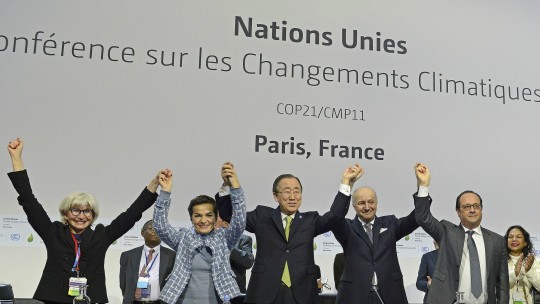COP21 Conference a Success

COP21 leaders celebrating their success.
On December 12, 2015, a milestone conference made global climate change a primary goal for governments everywhere. Paris, France, was the site of the 21st Conference of the Parties to the United Nations Framework Convention on Climate Change, or COP 21. There, nearly two hundred countries agreed on a plan to minimize environmental change by keeping global temperature change beneath two degrees Celsius.
According to the Center for Climate and Energy Solutions, during the conference itself, over 150 prime ministers and presidents attended, which is the largest gathering of heads-of-state ever. Many others attended, including CEOs, mayors, and even Bill Gates. These people came together from all over the Earth to argue and discuss our planet’s climate and government responsibility. However, the new document did not come about very easily: “Negotiations on many issues were hard-fought and, in typical COP fashion, progress through most of the conference was painstakingly slow,” said one Center for Climate and Energy Solutions article, “But thanks to deft diplomacy by the French presidency, the summit was remarkably free of the kind of procedural showdowns that have marred previous COPs.”
The two-week conference ended with 195 countries’ historical agreement on a concrete plan, not just an objective. According to COP21’s news site, all major goals were covered in not only the discussions but also the final write-up. Here is a short outline:
- Mitigation, which involves reducing emissions fast enough to keep this century’s total temperature rise under two degrees Celsius
- A way to account for which countries contribute most (or least) through global stocks and a system of updated climate plans submitted every five years
- Plans to strengthen countries’ abilities to recover from the negative impacts of climate change
- Plans for finances and support systems for nations to build resilient and clean futures
The strategy for countries to keep track of each other’s progress is through climate action plans and follow-up reports. Already 188 countries have submitted these plans.
The conference and its goal to limit global warming to two degrees is important for every country on the planet, but more so for third-world countries than first; first world countries can deal with climate change easily as they have a lot of resources, however third world countries do not. For example, the USA has a plethora of agricultural resources (from corn to oranges); if one crop fails, we not only have more crops to feed us but also factories, businesses, and even more. Many third-world countries, however, only have one crop. And if global warming or climate change destroys their one crop, unlike us, they will not be able to recover. The Paris agreement seriously aids our entire world, however, not just the third-world countries; UN Secretary General Ban Ki-moon said, “For the first time, every country in the world has pledged to curb emissions, strengthen resilience and join in common cause to take common climate action.”
“The Paris Agreement also sends a powerful signal to the many thousands of cities, regions, businesses and citizens across the world already committed to climate action that their vision of a low-carbon, resilient future is now the chosen course for humanity this century,” said Christiana Figueres, the Executive Secretary of the UN Framework on Climate Change. People already committed to helping the environment, she says, have been joined by the world’s governments, including our own. The extent to which our government will continue and assist, however, depends on which candidate wins the upcoming election.
The final document has not yet been signed, but will be given to the United Nations and will be open for signature starting on April 22, 2016, this year’s Earth Day. When 55 countries ratify plans that would eliminate 55% of the carbon emissions, the document will go into effect.
